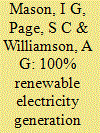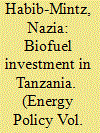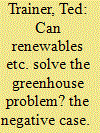|
|
|
Sort Order |
|
|
|
Items / Page
|
|
|
|
|
|
|
| Srl | Item |
| 1 |
ID:
097208


|
|
|
|
|
| Publication |
2010.
|
| Summary/Abstract |
The New Zealand electricity generation system is dominated by hydro generation at approximately 60% of installed capacity between 2005 and 2007, augmented with approximately 32% fossil-fuelled generation, plus minor contributions from geothermal, wind and biomass resources. In order to explore the potential for a 100% renewable electricity generation system with substantially increased levels of wind penetration, fossil-fuelled electricity production was removed from an historic 3-year data set, and replaced by modelled electricity production from wind, geothermal and additional peaking options. Generation mixes comprising 53-60% hydro, 22-25% wind, 12-14% geothermal, 1% biomass and 0-12% additional peaking generation were found to be feasible on an energy and power basis, whilst maintaining net hydro storage. Wind capacity credits ranged from 47% to 105% depending upon the incorporation of demand management, and the manner of operation of the hydro system. Wind spillage was minimised, however, a degree of residual spillage was considered to be an inevitable part of incorporating non-dispatchable generation into a stand-alone grid system. Load shifting was shown to have considerable advantages over installation of new peaking plant. Application of the approach applied in this research to countries with different energy resource mixes is discussed, and options for further research are outlined.
|
|
|
|
|
|
|
|
|
|
|
|
|
|
|
|
| 2 |
ID:
097434


|
|
|
|
|
| Publication |
2010.
|
| Summary/Abstract |
The potential for climate catastrophes, represented by 'fat-tailed' distributions on consequences, has attracted much attention recently. To date, however, most integrated assessment models have either been largely deterministic or deterministic with ex-post sensitivity analysis. The conclusions of such analyses are likely to differ from those employing models that accurately characterize society's joint preferences concerning time and risk, especially when distributions are fat-tailed. Using a dynamic stochastic general equilibrium model adapted from Nordhaus's DICE model, we show that failing to accurately account for risk can lead to substantial underestimation of the net benefits of greenhouse gas abatement. A robust finding of our analysis is that a lenient 'policy ramp' emissions reduction strategy is preferable over a more aggressive strategy-such as that advocated by the Stern Review-only if the model does not account for uncertainty about the climate system, the carbon cycle and economic damages, and specifies a consumption discount rate that is counterfactually higher than the historical global weighted average cost of capital of 4.0%. In the debate over uncertainty and time discounting, our results imply that what matters most in climate change assessment is the inclusion and particular specification of uncertainty rather than the precise choice of discount rate.
|
|
|
|
|
|
|
|
|
|
|
|
|
|
|
|
| 3 |
ID:
097346


|
|
|
|
|
| Publication |
2010.
|
| Summary/Abstract |
The majority of evidence on gasoline demand elasticities is derived from models based on national data. Since the largest growth in population is now taking place in cities in the developing world it is important that we understand whether this national evidence is applicable to demand conditions at the local level. The aim of this paper is to estimate and compare gasoline per vehicle demand elasticities at the national and local levels in Mexico. National elasticities with respect to price, income, vehicle stock and metro fares are estimated using both a time series cointegration model and a panel GMM model for Mexican states. Estimates for Mexico City are derived by modifying national estimates according to mode shares as suggested by Graham and Glaister (2006), and by estimating a panel Within Groups model with data aggregated by borough. Although all models agree on the sign of the elasticities the magnitudes differ greatly. Elasticities change over time and differ between the national and local levels, with smaller price responses in Mexico City. In general, price elasticities are smaller than those reported in the gasoline demand surveys, a pattern previously found in developing countries. The fact that income and vehicle stock elasticities increase over time may suggest that vehicles are being used more intensively in recent years and that Mexico City residents are purchasing larger vehicles. Elasticities with respect to metro fares are negligible, which suggests little substitution between modes. Finally, the fact that fuel efficiency elasticities are smaller than vehicle stock elasticities suggests that vehicle stock size, rather than its composition, has a larger impact on gasoline consumption in Mexico City.
|
|
|
|
|
|
|
|
|
|
|
|
|
|
|
|
| 4 |
ID:
097254


|
|
|
|
|
| Publication |
2010.
|
| Summary/Abstract |
Owing to booming mobile phone ownership and a short product innovation cycle, waste mobile phones are flooding China. In 2008, about 560 million mobile phones were produced and 634 million users subscribed to a mobile phone plan in China. These large numbers mean that the charging and disposal of mobile phones has the potential to have significant impacts on the environment. Thus the evaluation of material and energy consumption of mobile phones is an important task in the end-of-life management of electronic products. This paper uses material flow analysis (MFA) and life cycle assessment (LCA) methods to estimate the life cycle impacts of mobile phones in China from manufacturing energy, use phase and generation of waste mobile phones. Results indicate over the mobile phone life cycle, manufacturing accounts for 50% of the total energy consumption, whereas the use phase accounts for only 20%. Mobile phones and supporting infrastructures account for a rapidly increasing 0.17% of Chinese energy use. In 2008, around 77 million units of waste mobile phones were generated in China. To manage this energy use and recover valuable materials recommendations are made to increase lifespan, improve energy efficiency during use and ensure recycling.
|
|
|
|
|
|
|
|
|
|
|
|
|
|
|
|
| 5 |
ID:
097502


|
|
|
|
|
| Publication |
2010.
|
| Summary/Abstract |
This short communication examines whether or not U.S. natural gas consumption follows a stationary process. Unlike previous research that has focused on regional country or industrial sector-based panel studies, this study undertakes a sub-national investigation of natural gas consumption for the 50 U.S. states. Levin et al. (2002), Im et al. (2003), Maddala and Wu (1999), and Hadri (2000) panel unit root and stationarity tests reveal that natural gas consumption is integrated of order one. However, once allowance is made for endogenously determined structural breaks, the Carrion-i-Silvestre et al. (2005), Im et al. (2005), and Westerlund (2005) panel unit root and stationarity tests indicate that natural gas consumption is integrated of order zero. Discussion of the structural breaks is briefly surveyed in relation to the natural gas industry's response to legislative actions.
|
|
|
|
|
|
|
|
|
|
|
|
|
|
|
|
| 6 |
ID:
097440


|
|
|
|
|
| Publication |
2010.
|
| Summary/Abstract |
In recent years, the Taiwanese government has vigorously promoted the development of renewable energy to engage the challenges of gradual depletion of fossil fuels and oil, as well as the intensification of the greenhouse effect. Since the Sustainable Energy Policy Principles were announced in 2008, Taiwanese government has declared that the development of renewable energy should take into account goals that pertain to energy, the environment, and the economy (3E goals). This study aims to assess the 3E goals and renewable energy sources regulated by the Renewable Energy Development Bill that passed in 2009. The fuzzy analytic hierarchy process (FAHP) is used to resolve the multi-goal problem for achieving our research purposes. That is, this research attempts to reveal the suitable renewable energy sources for the purposes of meeting the 3E policy goals. The results first show that environmental goal is the most important to the development of various renewable energy technologies in Taiwan, followed by the economic and energy goals. Additionally, hydropower, solar energy, and wind energy would be the renewable energy sources utilized in meeting the 3E policy goals.
|
|
|
|
|
|
|
|
|
|
|
|
|
|
|
|
| 7 |
ID:
097482


|
|
|
|
|
| Publication |
2010.
|
| Summary/Abstract |
In recent years, the Taiwanese government has vigorously promoted the development of renewable energy to engage the challenges of gradual depletion of fossil fuels and oil, as well as the intensification of the greenhouse effect. Since the Sustainable Energy Policy Principles were announced in 2008, Taiwanese government has declared that the development of renewable energy should take into account goals that pertain to energy, the environment, and the economy (3E goals). This study aims to assess the 3E goals and renewable energy sources regulated by the Renewable Energy Development Bill that passed in 2009. The fuzzy analytic hierarchy process (FAHP) is used to resolve the multi-goal problem for achieving our research purposes. That is, this research attempts to reveal the suitable renewable energy sources for the purposes of meeting the 3E policy goals. The results first show that environmental goal is the most important to the development of various renewable energy technologies in Taiwan, followed by the economic and energy goals. Additionally, hydropower, solar energy, and wind energy would be the renewable energy sources utilized in meeting the 3E policy goals.
|
|
|
|
|
|
|
|
|
|
|
|
|
|
|
|
| 8 |
ID:
097439


|
|
|
|
|
| Publication |
2010.
|
| Summary/Abstract |
Promoting energy efficiency in the building sector is essential if the agreements of the Kyoto Protocol are to be honoured. Different initiatives for energy labelling of highly energy-efficient residential buildings have emerged throughout Europe as an essential method to stimulate market demand, to control grants or to ensure the quality of demonstration projects with excellent energy performance.
The paper identifies the barriers and opportunities for the further diffusion of labels for highly energy-efficient houses. A model based on the theory of the diffusion of innovation is developed to analyse perceived attributes of existing European labels. The paper investigates the innovation characteristics of existing labels in Europe, with a focus on advanced countries. The question of compatibility with the development of the European Energy Performance of Buildings Directive (EPBD) is examined in detail.
We found that the diffusion of emerging and already existing voluntary European labels for highly energy-efficient houses is needed. Their complexity can be lowered and relative advantage, trialability, observability, and compatibility can be increased. EPBD calculation procedures should be able to receive highly energy-efficient houses. In the framework of the recast of the EPBD, official recognition of existing voluntary labels is recommended.
|
|
|
|
|
|
|
|
|
|
|
|
|
|
|
|
| 9 |
ID:
097432


|
|
|
|
|
| Publication |
2010.
|
| Summary/Abstract |
Hotel buildings are reported in many countries as one of the most energy intensive building sectors. Besides the pressure posed on energy supply, they also have adverse impact on the environment through greenhouse gas emissions, wastewater discharge and so on. This study was intended to shed some light on the energy and environment related issues in hotel industry. Energy consumption data and relevant information collected from hotels were subjected to rigorous statistical analysis. A regression-based benchmarking model was established, which takes into account, the difference in functional and operational features when hotels are compared with regard to their energy performance. In addition, CO2 emissions from the surveyed hotels were estimated based on a standard procedure for corporate GHG emission accounting. It was found that a hotel's carbon intensity ranking is rather sensitive to the normalizing denominator chosen. Therefore, carbon intensity estimated for the hotels must not be interpreted arbitrarily, and industry specific normalizing denominator should be sought in future studies.
|
|
|
|
|
|
|
|
|
|
|
|
|
|
|
|
| 10 |
ID:
097337


|
|
|
|
|
| Publication |
2010.
|
| Summary/Abstract |
The Brazilian National Program for Production and Use of Biodiesel (PNPB in Portuguese) has created a huge demand for biodiesel in Brazil. The PNPB is strongly based on social development through the inclusion of family farmers in projects integrated with biodiesel power plants. Among the various oilseeds, castor bean (Ricinus communis L.) was identified as the ideal one to promote social development in the semi-arid region. However, although promising, the mechanisms of the federal program are still insufficient to promote the effective participation of family farmers. This research shows that companies are facing huge problems in implementing contracts with family farmers. It describes and analyzes the functioning dynamics of this agro-production chain. This paper addresses the identification and the discussion of these obstacles, in order to increase the competitiveness of the biodiesel agribusiness chain, based on castor oil social projects in Brazil.
|
|
|
|
|
|
|
|
|
|
|
|
|
|
|
|
| 11 |
ID:
097216


|
|
|
|
|
| Publication |
2010.
|
| Summary/Abstract |
The Brazilian National Program for Production and Use of Biodiesel (PNPB in Portuguese) has created a huge demand for biodiesel in Brazil. The PNPB is strongly based on social development through the inclusion of family farmers in projects integrated with biodiesel power plants. Among the various oilseeds, castor bean (Ricinus communis L.) was identified as the ideal one to promote social development in the semi-arid region. However, although promising, the mechanisms of the federal program are still insufficient to promote the effective participation of family farmers. This research shows that companies are facing huge problems in implementing contracts with family farmers. It describes and analyzes the functioning dynamics of this agro-production chain. This paper addresses the identification and the discussion of these obstacles, in order to increase the competitiveness of the biodiesel agribusiness chain, based on castor oil social projects in Brazil.
|
|
|
|
|
|
|
|
|
|
|
|
|
|
|
|
| 12 |
ID:
097209


|
|
|
|
|
| Publication |
2010.
|
| Summary/Abstract |
Increasing demand for biofuels as a component of climate change mitigation, energy security, and a fossil fuel alternative attracts investors to developing countries like Tanzania. Ample unused land is critical for first generation biofuels production and an important feature to attract foreign direct investments that can contribute towards agricultural modernization and poverty reduction initiatives. Despite the economic justifications, the existing institutional and infrastructural capacities dictate the impacts of biofuels market penetrations. Furthermore, exogenous factors like global recessionary pressure depressed oil prices below the level at which biofuel production were profitable in 2007, making Tanzania's competitiveness and potential benefits questionable.
This paper investigates the extent that first generation, jatropha-based biofuels industry development in Tanzania observed during fieldwork in Kisarawe and Bahi may fulfill policy objectives. This paper argues that without strong regulatory frameworks for land, investment management, and rural development, biofuel industrialization could further exacerbate poverty and food insecurity in Tanzania. The paper concludes with policy recommendations for first generation biofuel development while keeping in mind implications of second generation production. Since the topic is broad and multifaceted, a multidisciplinary approach is used that includes political, institutional, and agricultural economics to analyze and conceptualize biofuel industry development and food security.
|
|
|
|
|
|
|
|
|
|
|
|
|
|
|
|
| 13 |
ID:
097430


|
|
|
|
|
| Publication |
2010.
|
| Summary/Abstract |
Biomasses created from natural resources such as firewood, charcoal and forest crops are still the main source of energy in many communities in the developing countries of the world. The absence of modern techniques, in terms of energy conversion and the lack of resource planning, places a great burden on the environment, not only in terms of deforestation but the polluting residual emissions created by the burning of such fuels. Even in some developed countries, it is possible to find rural areas that have no access to the conventional national electrical grid. The lack of this facility is detrimental to the social and economic development of any country or community. Renewable energy systems have been used in many cases to mitigate these problems. The present paper introduces the concept of an alternative Hybrid Power System configuration that combines photovoltaic modules and digesters fuelled by goat manure as the basis for rural sustainable development. Attention is drawn to the Northeast Region of Brazil, one of the largest semi-arid regions in a single country. The regional conditions of Northeast of Brazil are not unique, suggesting that other countries of a similar nature would benefit from the same energy system.
|
|
|
|
|
|
|
|
|
|
|
|
|
|
|
|
| 14 |
ID:
097251


|
|
|
|
|
| Publication |
2010.
|
| Summary/Abstract |
Virtually all current discussion of climate change and energy problems proceeds on the assumption that technical solutions are possible within basically affluent-consumer societies. There is however a substantial case that this assumption is mistaken. This case derives from a consideration of the scale of the tasks and of the limits of non-carbon energy sources, focusing especially on the need for redundant capacity in winter. The first line of argument is to do with the extremely high capital cost of the supply system that would be required, and the second is to do with the problems set by the intermittency of renewable sources. It is concluded that the general climate change and energy problem cannot be solved without large scale reductions in rates of economic production and consumption, and therefore without transition to fundamentally different social structures and systems.
|
|
|
|
|
|
|
|
|
|
|
|
|
|
|
|
| 15 |
ID:
097249


|
|
|
|
|
| Publication |
2010.
|
| Summary/Abstract |
At present carbon capture and storage (CCS) is very expensive and its performance is highly uncertain at the scale of commercial power plants. Such challenges to deployment, though, are not new to students of technological change. Several successful technologies, including energy technologies, have faced similar challenges as CCS faces now. To draw lessons for the CCS industry from the history of other energy technologies that, as with CCS today, were risky and expensive early in their commercial development, we have analyzed the development of the US nuclear-power industry, the US SO2-scrubber industry, and the global liquefied natural gas (LNG) industry. Through analyzing the development of the analogous industries we arrive at three principal observations. First, government played a decisive role in the development of all of these analogous technologies. Second, diffusion of these technologies beyond the early demonstration and niche projects hinged on the credibility of incentives for industry to invest in commercial-scale projects. Third, the conventional wisdom that experience with technologies inevitably reduces costs does not necessarily hold. Risky and capital-intensive technologies may be particularly vulnerable to diffusion without accompanying reductions in cost.
|
|
|
|
|
|
|
|
|
|
|
|
|
|
|
|
| 16 |
ID:
097437


|
|
|
|
|
| Publication |
2010.
|
| Summary/Abstract |
Modern forms of energy are an important vehicle towards poverty alleviation in rural areas of developing countries. Most developing countries' households rely heavily on wood fuel which impacts on their health and socio-economic status. To ease such a dependency, other modern forms of energy, namely electricity, need to be provided. However, the quality of the electricity service, namely reliability, is an important factor in reducing this dependency. This paper discusses a choice experiment valuation study conducted among electrified rural households located in Kisumu, Kenya, in which the willingness to pay (WTP) to avoid power outages or blackouts was estimated. A mixed logit estimation was applied to identify the various socio-economic and demographic characteristics which determine preferences in reducing power outages among a household's users. In conclusion, several of the socio-economic and demographic characteristics outlined in this paper were identified and can assist service differentiation to accommodate the diverse households' preferences towards the improvement of the electricity service.
|
|
|
|
|
|
|
|
|
|
|
|
|
|
|
|
| 17 |
ID:
097428


|
|
|
|
|
| Publication |
2010.
|
| Summary/Abstract |
This study presents a comparative analysis of three different energy production process (EPP) scenarios for Turkey. Main goal is to incorporate the prioritization criteria for the assessment of various energy policies for power alternatives, and evaluating these policies against these criteria. The three types of EPPs reviewed in this study are: electricity production from wind farms in the future, existing coal-based thermal power plants and planned nuclear power plants. The analytical hierarchy process (AHP) is utilized to assess the main and sub-factors of EPPs. Main factors such as economic, technical, social and environmental are assigned in first level of the AHP. The importance weights of factors are produced and priority values with realistic numbers are obtained using Fuzzy-AHP Chang's Model. Priority value for wind energy was determined as two times higher than the others when making the ultimate decision. On aggregate, importance weights of environmental (0.68) and social (0.69) factors make wind power leader. Sub-factors such as public acceptance, waste-emission and environmental impacts cause both nuclear and thermal power to have the lowest priority numbers. Additionally, the CO2 emissions trade was determined to be a very important criterion associated with both economic and environmental factors according to Kyoto Protocol. This study concludes that Turkey's existing thermal power stations should gradually be substituted by renewable energy options according to a schedule of Turkish energy policies in future.
|
|
|
|
|
|
|
|
|
|
|
|
|
|
|
|
| 18 |
ID:
097497


|
|
|
|
|
| Publication |
2010.
|
| Summary/Abstract |
This article examines potential cost reductions in the market for balancing power by pooling all four German control areas. In a united control area both the procurement and the production of balancing power may be more efficient than in four separated control areas. Our data contain bids on energy procurement as well as balancing power flows in the period from December 2007 to November 2008. A reference scenario simulates the market results for secondary and tertiary balancing power. Subsequently, we simulate a united control area. We show that in the period under review the total costs of balancing power are reduced by 17%.
|
|
|
|
|
|
|
|
|
|
|
|
|
|
|
|
| 19 |
ID:
097492


|
|
|
|
|
| Publication |
2010.
|
| Summary/Abstract |
In June 2009, a new EU directive on the promotion of renewable energy sources (RES) entered into effect. The directive 2009/28/EC, provides for three cooperation mechanisms that will allow member states to achieve their national RES target in cooperation with other member states: statistical transfer, joint projects, and joint support schemes. This article analyses the pros and cons of the three mechanisms and explores design options for their implementation through strategic and economic questions: How to counterbalance the major drawbacks of each mechanism? How to reflect a balance of costs and benefits between the involved member states? The analysis identifies a number of design options that respond to these questions, e.g. long term contracts to ensure sufficient flexibility for statistical transfers, a coordinated, standardised joint project approach to increase transparency in the European market, and a stepwise harmonisation of joint support schemes that is based on a cost-effective accounting approach. One conclusion is that the three cooperation mechanisms are closely interlinked. One can consider their relation to be a gradual transition from member state cooperation under fully closed national support systems in case of statistical transfers, to cooperation under fully open national support systems in a joint support scheme.
|
|
|
|
|
|
|
|
|
|
|
|
|
|
|
|
| 20 |
ID:
097338


|
|
|
|
|
| Publication |
2010.
|
| Summary/Abstract |
This paper analyses the design of carbon markets in space (i.e., geographically). It is part of a twin set of papers that, starting from first principles, ask what an optimal global carbon market would look like by around 2030. Our focus is on firm-level cap-and-trade systems, although much of what we say would also apply to government-level trading and carbon offset schemes. We examine the "first principles" of spatial design to maximise flexibility and to minimise costs, including key design issues in linking national and regional carbon markets together to create a global carbon market.
|
|
|
|
|
|
|
|
|
|
|
|
|
|
|
|
|
|
|
|
|